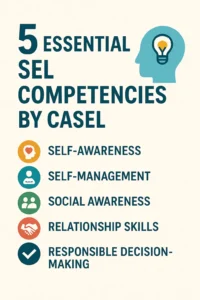
How to Introduce SEL in Primary Schools?
Introduction
Social and Emotional Learning (SEL) fosters emotional intelligence, empathy, and resilience. In primary schools, early SEL implementation is essential for shaping well-rounded, mentally healthy students.
The Five SEL Competencies
According to CASEL (Collaborative for Academic, Social, and Emotional Learning), SEL is organized around five competencies:
- Self-Awareness
- Self-Management
- Social Awareness
- Relationship Skills
- Responsible Decision-Making
Step-by-Step Strategy for Introducing SEL
- Create a schoolwide vision and framework
- Train teachers and staff on SEL techniques
- Embed SEL into daily routines (e.g., morning check-ins)
- Use children’s literature to explore emotions and values
- Build a classroom culture of inclusion and respect
- Implement evidence-based SEL curricula
- Engage families in SEL learning at home
- Encourage reflection through journaling
Measuring Impact
Track SEL success using behavior reports, surveys, student journals, and performance rubrics. Celebrate progress and share success stories.
Benefits of SEL in Primary Education
- Improved academic performance
- Stronger emotional regulation
- Healthier relationships among peers
- Reduction in behavioral issues
Conclusion
Introducing SEL in primary schools equips children with essential life skills. With the right approach, SEL becomes a foundation for academic excellence and lifelong emotional health.

